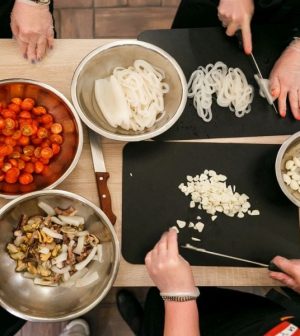- Navigating Your Midlife Crisis: Embracing New Possibilities
- City Raccoons Showing Signs of Domestication
- Mapping the Exposome: Science Broadens Focus to Environmental Disease Triggers
- One Week Less on Social Media Linked to Better Mental Health
- Your Brain Changes in Stages as You Age, Study Finds
- Some Suicide Victims Show No Typical Warning Signs, Study Finds
- ByHeart Formula Faces Lawsuits After Babies Sickened With Botulism
- Switch to Vegan Diet Could Cut Your Greenhouse Gas Emissions in Half
- Regular Bedtime Does Wonders for Blood Pressure
- Dining Alone Could Mean Worse Nutrition for Seniors
Holiday Meals Mean Safety First in Your Kitchen

Knives, vegetable peelers, blenders: There are plenty of ways to injure yourself in the kitchen during the holidays.
To keep things merry, cheery and safe, experts at Midwest Orthopaedics at RUSH (MOR) in Chicago say there are simple steps you and those who are helping you cook can take to stay safe.
They point out that every year 350,000 people are seen in U.S. emergency rooms for knife injuries alone.
“I see a big increase in hand and finger injuries from kitchen accidents over the holidays,” Dr. Xavier Simcock, a MOR hand and wrist surgeon, said in a MOR news release. “I’ve treated patients who have mistakenly cut themselves while carving turkeys or dropping holiday dishes. It can happen so easily, especially with momentary distractions.”
What might initially seem like a minor cut to the hand could be far more serious, added Dr. Mark Cohen, another MOR hand and wrist surgeon.
“If a tendon, which is key to moving our hands and fingers, is cut, it can be hard to re-attach surgically and for the injured person to regain full mobility,” he explained. “And severing a nerve can cause feeling to be lost in that extremity.”
Luckily, sticking to safer techniques for carving turkeys or chopping vegetables can keep holidays injury-free.
Kristen Grider is a MOR occupational therapist who often treats hand and finger injuries. She offered up these kitchen safety tips:
-
Keep knives sharp. That means less pressure is needed for cutting, which reduces the likelihood a knife will slip.
-
Keep surfaces well-lit and dry. Seeing what you’re doing and reducing the odds for slipping are key.
-
Always slice away from yourself and make sure fingers aren’t near the blade.
-
Never try cutting an object while it’s in the palm of your hand — use a cutting board.
-
Got a round object? Cut it in half first, then rest the flat side on a cutting board to finish the job.
-
Leaving dirty knives in the sink is an easy way to accidentally cut yourself while cleaning up. Washing knives soon after use can prevent that.
-
Concentrate on whatever cooking task is at hand. Don’t be distracted by chatter or the TV.
-
Keep your fingers OUT of the blender at all times, even if it’s off but still plugged in.
-
Don’t drink alcohol when using knives or handling glass.
-
If you happen to break a glass, let it fall to the floor — don’t try to grasp it mid-air. Use rubber gloves to pick up shards and vacuum the area thoroughly after sweeping up.
More information
Find out more about treating cuts at the American Academy of Dermatology
SOURCE: Midwest Orthopaedics at RUSH, news release, Dec. 7, 2023
What This Means for You
Making holiday meals can have hazards — simple steps can keep you injury-free in the kitchen.
Source: HealthDay
Copyright © 2025 HealthDay. All rights reserved.










